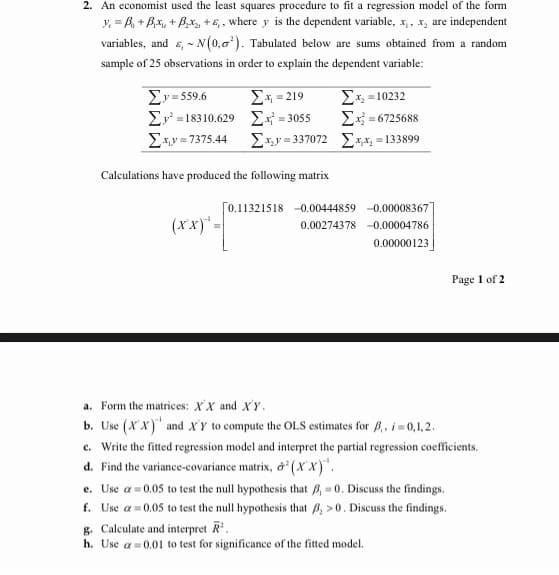2. An economist used the least squares procedure to fit a regression model of the form y₁=B₁ + B₁x₂, + B₂x₂, +,, where y is the dependent variable, x, , x, are independent variables, and ,- N(0,0). Tabulated below are sums obtained from a random sample of 25 observations in order to explain the dependent variable: Ex=219 Σπ= 3055 Σx,y – 337072 Calculations have produced the following matrix y=559.6 Σ»-18310.629 Σχν=7375.44 (xx)= Σπ. – 10232 Σε 6725688 Σxx, = 133899 [0.11321518 -0.00444859 -0.00008367] 0.00274378 -0.00004786 0.00000123 Page 1 of 2 a. Form the matrices: X'X and XY. b. Use (XX) and XY to compute the OLS estimates for P., i=0,1,2. c. Write the fitted regression model and interpret the partial regression coefficients. d. Find the variance-covariance matrix, &¹ (XX)". e. Use a=0.05 to test the null hypothesis that A-0. Discuss the findings. f. Use a=0.05 to test the null hypothesis that B, >0. Discuss the findings. g. Calculate and interpret R¹. h. Use a 0,01 to test for significance of the fitted model.
2. An economist used the least squares procedure to fit a regression model of the form y₁=B₁ + B₁x₂, + B₂x₂, +,, where y is the dependent variable, x, , x, are independent variables, and ,- N(0,0). Tabulated below are sums obtained from a random sample of 25 observations in order to explain the dependent variable: Ex=219 Σπ= 3055 Σx,y – 337072 Calculations have produced the following matrix y=559.6 Σ»-18310.629 Σχν=7375.44 (xx)= Σπ. – 10232 Σε 6725688 Σxx, = 133899 [0.11321518 -0.00444859 -0.00008367] 0.00274378 -0.00004786 0.00000123 Page 1 of 2 a. Form the matrices: X'X and XY. b. Use (XX) and XY to compute the OLS estimates for P., i=0,1,2. c. Write the fitted regression model and interpret the partial regression coefficients. d. Find the variance-covariance matrix, &¹ (XX)". e. Use a=0.05 to test the null hypothesis that A-0. Discuss the findings. f. Use a=0.05 to test the null hypothesis that B, >0. Discuss the findings. g. Calculate and interpret R¹. h. Use a 0,01 to test for significance of the fitted model.
Linear Algebra: A Modern Introduction
4th Edition
ISBN:9781285463247
Author:David Poole
Publisher:David Poole
Chapter7: Distance And Approximation
Section7.3: Least Squares Approximation
Problem 34EQ
Related questions
Question
100%

Transcribed Image Text:2. An economist used the least squares procedure to fit a regression model of the form
y₁ =B₁ + B₁x₁₂ + B₂x₂, +s, where y is the dependent variable, x₁, x, are independent
variables, and s, ~ N(0,0). Tabulated below are sums obtained from a random
sample of 25 observations in order to explain the dependent variable:
Ev=5596
Er =
Σ.Χ.μ – 7375.44
Calculations have produced the following matrix
=18310.629
Σχ = 219
Σε=:
(xx)' =
= 3055
Σκv=337072
Σχ. = 10232
Ex=6725688
Σxx, = 133899
[0.11321518 -0.00444859 -0.00008367
0.00274378 -0.00004786
0.00000123
Page 1 of 2
a. Form the matrices: X'X and XY.
b. Use (XX) and XY to compute the OLS estimates for p,, i=0,1,2.
c. Write the fitted regression model and interpret the partial regression coefficients.
d. Find the variance-covariance matrix, (XX).
e. Use a = 0,05 to test the null hypothesis that ß, =0. Discuss the findings.
f. Use = 0.05 to test the null hypothesis that , >0. Discuss the findings.
g. Calculate and interpret R¹.
h. Use a=0.01 to test for significance of the fitted model.
Expert Solution
This question has been solved!
Explore an expertly crafted, step-by-step solution for a thorough understanding of key concepts.
Step by step
Solved in 5 steps with 33 images

Recommended textbooks for you

Linear Algebra: A Modern Introduction
Algebra
ISBN:
9781285463247
Author:
David Poole
Publisher:
Cengage Learning

Linear Algebra: A Modern Introduction
Algebra
ISBN:
9781285463247
Author:
David Poole
Publisher:
Cengage Learning